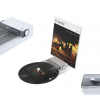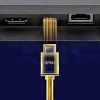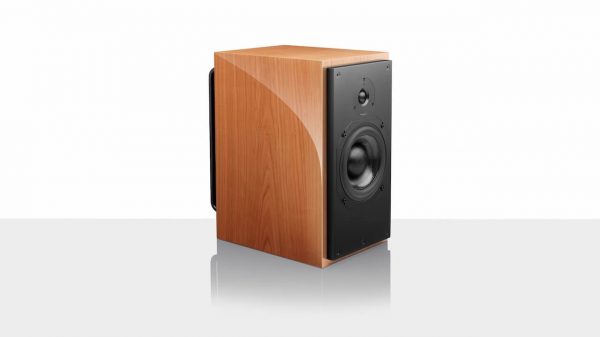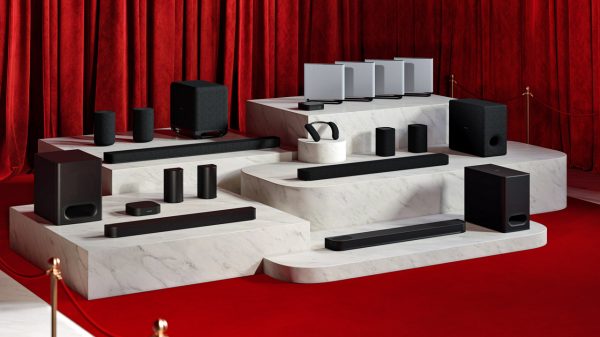Over the past 23 years, I’ve intentionally avoided calling any product the “Best” I’ve ever heard for the simple reason that it’s not a statement with any degree of longevity. But could a soundbar system from Theory Audio Design move the needle enough for me to reconsider everything that I know about surround sound at home?
As much as I love music, movies have always been my passion. I own more than 3,700 different titles and I am confident claiming that I may be the only person in New Jersey to have seen every new film release during the pandemic at his local AMC. How often have I attended films since theaters reopened locally on the Jersey Shore in the summer of 2020?
According to my bank records, I’ve watched more than 64 movies alone (or with my kids) at my local AMC and only 10 of those films were classics from the 1980s like the 40th anniversary showing of The Empire Strikes Back.
I watch a lot of movies. I skipped two days of school in 1983 (I was 13) to be the first person in line to see The Return of the Jedi. The subsequent grounding that lasted until January 1984 was well worth it.
Being stuck at home during the lockdowns forced us to home school 3 children on Zoom for almost 5 months, leaving us with only a few hours at night (utterly exhausted) to enjoy new movies or television programs on Netflix, Amazon Prime, Hulu, Disney+, and Vudu.
So much for cutting the cord.
My family doesn’t share my intense passion for older films; Kurosawa, Wilder, Fuller, Hitch, Scorsese, Ridley Scott, Woo, and Kubrick all take me someplace new every single time I watch one of their films.
Our basement home theater space can be a lonely place at night. I watch alone because the movie watching experience allows me to feel a different sense of focus; my mind is always working, possibly too hard on things that don’t need to be fixed at that very moment. The manic side of me doesn’t want drugs, alcohol, gambling, or online fights with woke idiots who have never picked up a book or watched a decent film in their lives.
Films bring me a sense of calm. I need it after ten hours of writing and editing all day long.
A huge part of that experience is the sound.
A part of me understands why some people don’t enjoy home theater. They think it’s a gimmick; a parlor trick to get between you and your wallet. When it comes to older films that don’t have any special effects, I would normally agree that a solid 2-channel system is all you really need.
But that part of me that has to watch The Ten Commandments, Star Wars, Yojimbo, Das Boot, Blade Runner, and 2001: A Space Odyssey multiple times every single year – it desperately needs a surround sound system to feel that I’m part of the action.
I’ve had the opportunity to enjoy private showings at the Dolby Theater in NYC where Atmos-encoded content can really mess with your head, but it’s never been that way at home.
Nothing has delivered the gravitas of the classic theaters of my youth; the Eglinton, Hyland, Hollywood, York, and University that made Toronto such a great place to experience movies growing up.

Until now.
Fasten your seatbelts. It’s going to be a bumpy night.
Soundbars. People love them. I’m not entirely sure why.
Strip away the slim form factor, wireless audio connectivity, and affordability – what do you have left?
A box made of plastic with tiny loudspeaker drivers trying to replicate the dynamic swings, detail, scale, and emotional impact of movie soundtracks that were recorded and mixed for playback in cavernous movie auditoriums with screens that average anywhere between 45-50 feet in width.
How wide is your TV or projector screen at home? Put away the tape measure.
Soundbars may offer convenience and affordability, but they certainly don’t offer a true cinematic experience.
Paul Hales and I discuss the limitations of soundbars, and other loudspeakers in an interview that you can find here.
And please don’t confuse “loud” with “dynamics,” because they are not the same thing.
Meet the new boss. Definitely not the same as the old boss.

Theory Audio Design might be a new brand in the residential home theater space, but its origins in the larger pro audio and commercial world give it a different advantage in this category. That level of sonic performance also comes with a serious price tag – but as I discovered, it might be the most affordable way to achieve commercial theater level audio performance in a package that you can purchase today.
The Theory Audio Design 5.2.2 system (the systems can be configured for 2.0, 2.1, 3.0, 3.1, 3.2, 5.1, etc.) doesn’t come in exotic wood finishes or with cheap looking grilles; this is pro audio level loudspeaker technology designed to work at home in your living room, den, bedroom, or dedicated home theater space.
The first thing you’ll notice when you carry these very heavy loudspeakers into your listening space is that they are built to a much higher standard. Bend with the knees. You’ll be sorry if you don’t. Not once ounce of cheap plastic anywhere to be found.
Do you like Porsche? I’ve always been a 928 GTS person myself. One can tell that Paul Hales views his products through the same lens.
The Theory 5.2.2 is built for people who don’t mind paying for quality if it’s the real thing.
Theory sb75 Soundbar

The soundbar utilizes six 5” carbon fiber low frequency drivers and three 1.4” polymer compression driver tweeters. Theory rates the power handling at 200W per channel (AES method), with a 4-ohm impedance. The soundbar’s rated frequency bandwidth is 58 Hz to 23 kHz with a maximum output of 117 dB per channel. The sensitivity rating is 94 dB.
Weighing in at 68 pounds, you will need more than one person to help you mount it or place on the brackets if being set-up on a credenza. Dimensions are 9.5″ H x 66″ W x 3.8″ D.
Theory sb25 On-Wall Multi-Use Loudspeaker

I was surprised by the depth of these loudspeakers which were clearly designed to be used in wall-mount applications. Like the soundbar, they are designed to be powered by the Theory ALC and operate like an active loudspeaker.
The sb25 are the equivalent of a single channel on the soundbar, with the same specifications for the drivers and overall performance. They weigh 27 pounds and are 21.5″ H x 9.5″ W x 3.8″ D.
If you’re interested in a 2.0 or 2.1 system, the sb25 offer the same sonic signature and explosive dynamic capabilities of the larger soundbar in a smaller loudspeaker. The build quality on these loudspeakers suggests that they will survive longer than their owners.
Theory sub15 In-Room Subwoofer

This is a ported sub with a 15” Theory driver featuring a 3” voice coil. The rated frequency bandwidth is 22 Hz to 125 Hz with 500W (AES) /1000 W (continuous) power handling.
Each subwoofer weighs 76 pounds and the cabinet measures 21.3” H x 23.5” W x 19.8” D.
One thing I learned during the set-up is that the sub15 are far easier to configure than other subwoofers in the same price category. Theory hasn’t made these subwoofers idiot-proof but combined with the ALC – installation required only small adjustments in regard to placement away from the wall and corners.
Theory Audio ALC-1809 Amplified Loudspeaker Controller

The core of every Theory Audio Design loudspeaker system is the ALC-1809 which automatically configures itself for high-resolution DSP of the Theory loudspeaker models that you select; it sets the audio levels, delays, bass management and signal routing within the system. The ALC-1809 offers 9 high power amplifier channels, 8 balanced audio inputs, and 32-bit/96kHz DSP processing.
It also offers 8×8 matrix bass-management, 8×8 matrix mixing, 160 parametric EQ’s (20 per channel), automatic audio signal ducking for intercom and paging (perfect to allow Amazon Alexa and other voice assistants to page any or all of the distributed audio system channels), Internal band-limited and full band pink noise and sine sources, and up 75msec of delay per channel. All of this is packed in a fan-less 1U chassis.

Set-Up
Do not be intimidated by all of the boxes, manuals, and the very sleek set-up interface that Theory Audio Design have created to run the system. It’s actually quite easy to use and very intuitive. Paul Hales did give me more than one private tutoring session with the system and you should expect nothing less from the dealer who installs it.
One thing that did surprise me – the Theory Audio design 5.2.2 system does not utilize a mic to run a room analysis and system calibration. You simply measure the exact distance from each loudspeaker to your listening position and enter the distances into the interface.

You select your configuration from the menu on the left side of the screen and everything adjusts itself. Remember to apply each step as you go during the set-up process. Just click on the button on the right side of the screen so that the calculations can be made by the software.
I used the 5.2.2 system in my 33’ x 14’ x 9’ home theater room in the basement and the 3.1 system in our living room to see if the system would be too much for the 21’ x 16’ x 9’ space that is our primary movie/television watching space.
This is The Way
It should surprise no one that I began my critical listening with multiple episodes of The Mandalorian; and not just because I have been obsessed with Star Wars since 1977. During my listening sessions with the Sennheiser AMBEO and Enclave Audio CineHome Pro home theater systems, I found myself slightly underwhelmed watching the series.
The AMBEO does a lot of things really well, but a $2,500 soundbar has to elevate the experience to another level and I never really felt that it did. It does deliver a very transparent sounding experience with a lot of detail; the spaciousness of the sound really depends on the content you feed it.
That being said, the AMBEO doesn’t deliver the dynamic punch that I would expect from a product in this price range. Dialogue (with Dolby Atmos engaged) felt restricted to the front surface of the enclosure and never really engaged me. When I disengaged the Dolby Atmos setting, the AMBEO opened up and became far more spacious sounding, but I had to raise the volume to become more immersed in the dialogue.
The CineHome Pro (reviewed here) is a wireless home theater system that does not offer the technical sophistication of the AMBEO, but I enjoyed watching television and movies through it more. It’s less expensive, and surprisingly more engaging at moderate listening levels. Not a single person in my family disagreed with my assessment that it offered greater dynamics, cleaner sounding dialogue, and a more engaging experience compared to the Sennheiser soundbar.
But none of that could have prepared me for the changes to come with the Theory Audio Design system.
I’m a simple man making his way through the galaxy…
Star Wars fans can get very weird; I wear Han Solo t-shirts under $200 dress shirts in synagogue so don’t think that I’m judging anyone. I could feel the collective squeal when Boba Fett appeared in Season 2 of The Mandalorian. We’ve waited almost 30 years for the franchise to do something worthwhile that would redeem the infamous bounty hunter’s lame death in Return of the Jedi.
There is a moment in Season 2 (Chapter 14: The Tragedy), when the Razor Crest gets destroyed by a blast from Moff Gideon’s light cruiser.
The impact through the Theory Audio Design 5.2.2 system was a completely different experience; and not just because of the visceral impact from the 2 sub15 passive subwoofers. Consumers get excited by all of the wrong things when they purchase a home theater system; the obsession with volume (which is not the same thing as dynamics) and room-shaking bass response.
Stop pretending that your living room home theater system (which does not utilize professional acoustic treatment products) needs to sound like your local AMC or Cineplex.
Unless you have the budget to build a dedicated home theater in your home, the products that you can purchase from Best Buy or Amazon are not going to deliver an “authentic” movie theater experience.
The Theory Audio Design system was the first that I’ve ever tried in 20+ years of reviewing home theater products that delivered the scale, dynamics, and detail of the best movie theaters that I’ve spend the better part of 43 years escaping reality in.

The sub15s delivered the appropriate amount of bass when the Razor Crest detonated all over the hill; as opposed to other subwoofers that I’ve tried as part of home theater systems that delivered a lot of “boom” and “sizzle” but without any texture, articulation, or speed.
I didn’t just hear the ship explode; I felt it in my legs and chest from almost 13 feet away. I’ve experienced similar bass response from SVS subwoofers, but it felt disconnected from the rest of the soundtrack. There was no cohesiveness to the sound, and it obscured the detail that I wanted to discern from the LCR loudspeakers and the surround channels.
Subwoofers provide a foundation to the sound; as opposed to just adding a momentary rumble in your listening space. Products like the sub15s add an important layer to the overall sound that can’t be replicated by a tiny powered woofer in a box that came with your soundbar.
The Theory Audio Design products convey their pro audio/audiophile roots in that regard.
Paul Hales ran a very successful high-end loudspeaker company for many years and delivered loudspeakers that were big on transparency, coherency, and detail retrieval.
He also spent a few decades in the pro audio world where scale, dynamic capabilities, and tonal accuracy are very important.

The ability to deliver world-class performance in all of those categories is why the Theory Audio Design system is not only the best home theater system (with the Acurus Muse processor) below $20,000 that I’ve ever heard at home, but also the easiest to integrate into both living room scenarios and dedicated home theater systems.
A review of the Acurus Muse is forthcoming and was a major contributor to the sound of the system.
I ended up watching Rogue One, The Empire Strikes Back, Revenge of the Sith, and Solo through the Theory Audio 5.2.2 system and the consistency of the sonic performance was the underlying theme.
During the Battle of Scarif in Rogue One, Chirrut Imwe and Baze Malbus engage in a suicide mission against a platoon of Imperial Death troopers; it’s actually one of the few moments of gravitas in the entire franchise where we truly experience a sense of loss at the deaths of central characters.
There is so much going on in the both the scene and in the background; X-Wings and Tie-Strikers chasing one another over the watery surface of the planet, Imperial Death troopers dying from the penetrating blasts from Malbus’ heavy repeater cannon, the screams of the Rogue One assault team members dying from the impact of the Imperial AT-ACTs, and Chirrut’s chanting – it’s almost too much for any loudspeaker system to convey with any degree of separation, clarity, and detail.
The Theory Audio Design system reproduced this heart-racing sequence so well, I found myself lost in a film in a manner that I’ve not experienced in many years; just fully immersed in the battle itself and aware of the smallest details that made it feel real (even though there was nobody else in my dedicated home theater room).
We truly underestimate the importance of scale and dynamic capabilities in that regard when it comes to the home theater experience.
Not just in the big flourishes that make blockbuster films like Rogue One or Avengers: Endgame so exciting to watch on the big screen, but the quieter moments in film and television that convey emotion, setting, and atmosphere.
We’ve been watching a lot of television series on Netflix and Amazon Prime during the pandemic and the manner in which the Theory Audio Design system enhanced the experience can’t be overstated.
I’m a particular fan of The Killing, Hana, and Bosch; three series that put a lot of emphasis on setting and are very dark, moody, and tense dramas.
Bosch is based in Los Angeles, and the city plays a very important role in the story. The show’s strong dialogue propels it forward, but there a lot of moments where the sounds of the city are used to create mood and build up the tension; when Harry is home alone overlooking the millions of people below from his glass home on the hill and trying to push through the smog in his head and figure out the case.
Even using just the sb75 3-channel passive soundbar with one of the sb15 subwoofers in our living room created a completely different experience watching all of these shows.
The ability to hear music playing softly in the background, or identify outdoor sounds at varying distances — that’s not something you get to experience very often with traditional home theater systems. It creates another level of realism that immerses one in the storytelling.
The tonal balance of the entire system is extremely neutral; but it never strays into the analytical camp. Not for a second. Dialogue is clean, bold, and you are able to discern every nuance in a character’s voice. If you’re looking for a warm and fuzzy presentation that will make everything sound rolled off – this is not the system for you.
If you want to actually hear how a show or movie was recorded and mixed – this is the perfect system for you.
Even older films benefitted from the tonal balance, detail, clarity, and depth of the sound.

A copy of Criterion’s War of the Worlds landed on my doorstep and I was curious to see how the restoration would hold up; the latest version features both a 4K digital restoration, uncompressed monaural soundtrack, and a new alternate 5.1 DTS-HD Master Audio soundtrack.
The film doesn’t get very exciting until the Martian invaders decide to become “Thanos” and vaporize all of humanity, which is exactly when the Theory 5.2.2 system decided to create this massive soundstage in our living room and scare the crap out of the dog who hid under the sofa to escape the hulking alien ships and their green death rays.
Double Indemnity and Stalag 17 are two of my favorite all-time films and it was amazing to me how much more cinematic they felt through the Theory 5.2.2 system: a rather impressive feat considering the age of both films and the average sound quality of the films on Blu-ray.
But what about music?
I’m going to save that for a follow-up piece about multi-channel music, but I will share this little tidbit about the sb25 surface mount loudspeaker – there may not be a better option for a wall-mounted loudspeaker that can do both music/movies without compromise.
I’ve had a chance over the past few years to listen to about 2 dozen loudspeakers designed for this type of placement and the Theory Audio Design sb25 might be ideal for those who only have room for this type of loudspeaker in their den or bedroom, but do not want to sacrifice sound quality because of a lack of space.

Conclusion
I will never be able to afford the Theory Audio Design 5.2.2. system; a reality that makes me rather sad. It has completely moved the bar for me in regard to home theater sound and I’m grateful that I had the opportunity to try it. Paul Hales and his very talented (clearly) group of engineers have developed a modular system that can be used with both movies and music and in a multitude of configurations that will completely alter your perception of how movies and television can sound at home.
I almost want to pack-up my existing home theater system and pretend that surround sound does not exist and enjoy films in stereo only. That’s how large of a gap exists between my existing $10,000 home theater set-up and this system.
Using a race car analogy – like pulling up next to Ayrton Senna at Monaco in a ‘70s AMC Gremlin.
People spending $100,000 on a dedicated home theater will point to a dozen different loudspeaker options that sound sexier on paper, but save your money folks for a better projector, screen, furniture, and proper acoustic room treatment products.
The Theory Audio Design 5.2.2 surround system is unmatched below $20,000.
I wish I had 3 extra kidneys to sell. And one kid that I wouldn’t miss.
For more information: www.theoryaudiodesign.com
System Reviewed: 5.2.2 ATMOS Sound System with 75″ Soundbar and Dual 15″ subwoofers
- Loudspeaker Controller: 1 x ALC-1809
- Soundbar: 1 x sb75
- Surround Loudspeakers: 4 x sb25
- Subwoofers: 2 x sub15
Learn more: 6 Questions for Paul Hales, President Theory Audio Design







































Don Dunn
April 13, 2021 at 1:25 am
This system crushes for what it is…amazing design!
Terry Nelson
July 19, 2021 at 10:32 am
Interesting review and the reviewer obviously has knowledge of audio systems ! The idea of a putting the LCR channels into one, long cabinet is obviously a nod towards domestic installs where approval is required to put speakers that do not look ugly 😉
I would like to flag up two points concerning the review comments: first of all, the 0.1 channel – or LFE – is a dedicated channel for low frequency effects/content and really should only go to the subwoofers. Having Bass Management in the procressor seems a little strange if one is using the full system and would indicate that the main speakers do not have a fullrange response that is low enough.
Secondly, a Home Cinema that is worthy of the name, is just that – a small cinema in the home with (cannot emphasise it enough) proper acoustics! The best speakers in the world will sound poor in a barn or resonant space. Get the room right first and then worry about the sound and projection – you can easily do it for less than $100K. My 0.2c.
Vaal
October 19, 2022 at 7:40 pm
Interesting product…
But I’d like to point out that, as a reader, it is maddening when the price of the product under review is not clearly stated. You read through a review, it sounds great, wondering “ok, but how much? Am I getting excited by something I can afford or not?”
It’s annoying enough when a price is buried somewhere in a review that you have to search for. But to not even appear at all, not even with the specs, is very annoying.
“below $20,000 ”
Well…how much does it cost? Tell us, please!
Ian White
October 20, 2022 at 10:35 am
Vaal,
I’m not sure why that was edited out but weird.
Depending on which configuration 3, 3.1, 5.1, 5.2.2 (and you have to include the amp/controller), the range is $11,000 to around $15,000.
You also have to figure in the A/V Preamp which was $6,000 (Acurus MUSE).
Best,
Ian White
ORT
October 20, 2022 at 9:07 pm
First, well said Terry Nelson and in truth, all comments so far are right in their own way(s).
Given that a “home” theater is only a theater when viewing a film I would say I can under stand why some would prefer the less is more and go the soundbar route.
But for those able to spend $20,000 on their home setup? I would say that getting what they can afford is more than a step above the norm. If they choose a Soundbar, fine? If they decided on a 9.2 or 11.2 “Theatre” (European spelling ALERT!) that is fine too.
My spousal unit does NOT want either path in the family room. She has a HDTV and cable and is happy with that. I see no reason to waste time, my effort or my money in changing her mind and why should I? She is happy with what she has.
Me? I have a 9.2 Denon setup in a 10 X 10 room and I like it just fine. I dropped back to a pair of 8 inch subs from a pair of 10 inchers for reason that are, or were, very obvious.
Enjoy what you have and never think poorly of yourself for thinking about owning more. Or for that matter, less.
ORT
Ian White
October 21, 2022 at 1:26 am
ORT,
I generally dislike soundbars because they don’t come close at all to replicating what a proper 5.2.2 system can do — but the TAD system is very different.
The LCR soundbar in this system is massive. 85 pounds massive. I needed another adult to actually install it because of the size and weight. The build quality (unlike most soundbars) is on a completely different level.
The full-range nature of the LCR loudspeaker was something that I was not prepared for. It’s not about volume. It’s about dynamics and the ability to convey detail, nuance, space, and incredible speed.
The resolution is superb. The clarity is reference level.
But understand that this system is about the amp controller and A/V processor that you use as well. You have to use the TAD amp controller. They have new ones that are even better. I used a $6,000 A/V processor to see just how good this system could get — and it was painful to pack it back up and ship it back to California.
I will be buying it in 2023. Not the same configuration because my room has changed, but I’m unlikely to change it. Ever.
Ian White
Ed Brumbaugh
September 7, 2023 at 1:39 pm
ORT, well said. My late wife felt the same way, so I, like many I’m sure, lived that experience you pointed out. I currently enjoy a 7.2.4 GoldenEar/SVS sub setup in my basement theater room. I don’t pretend it’s better than my local theaters, but I sure enjoy it. Love reading about these higher end systems that cost more than my car / house … but I’m happy with what I’ve built out. At the end of the day … Enjoy your gear!!
Vaal
October 21, 2022 at 11:39 pm
Thanks very much for the price info!
Cheers.
Clint O.
November 12, 2022 at 9:02 am
Ian, I would really like to see you audition this against high end speakers for music reproduction. I’m confident it can do a good job with movies, but how does it stack up against traditional boxes & cones?
Ian White
November 12, 2022 at 12:32 pm
Clint,
I did listen to a lot of music through the TAD system in a 3.2 scenario. Its dynamic capabilities, resolution, and detail retrieval were first rate. Paul Hales is a music guy first and it shows.
A test like that might happen in Q1 2023.
Ian
Kenneth
November 14, 2022 at 8:18 am
Hello Ian,
You say that this system is the best “under $20,000.” So does that mean you have reviewed/experienced even better home theater sound systems which cost over $20k? Or do you have an article that touches on the absolute best overall disregarding price? Thank you.
Ian White
November 14, 2022 at 12:34 pm
Kenneth,
When it comes to the soundbar category, the TAD system is the best I’ve reviewed or heard below $20,000. Period. I’ve experienced some of the best dedicated HT systems up to $1M but that’s not the focus of the magazine. $20,000 is our ceiling when it comes to this kind of system. It’s an enormous investment.
Ian White
Leslie E
April 13, 2023 at 11:59 pm
Have you heard a Pro Audio Tech system (also by Paul Hales)?
Ian White
April 14, 2023 at 1:01 am
Les,
Yes and it had even superior dynamic range and clarity. It was also dramatically more expensive.
Paul makes wonderful products. The 85″ version of the TAD system is my “dream” home theater system.
Best,
Ian
Ed Brumbaugh
September 7, 2023 at 1:29 pm
3 extra kidneys to sell and one kid you wouldn’t miss … now that’s the best endorsement I’ve ever read!!! LOL! The system sounds amazing. Also, was glad to see your comment “Stop pretending that your living room home theater system (which does not utilize professional acoustic treatment products) needs to sound like your local AMC or Cineplex.” … exactly. Thanks for bringing us this Theory Audio system and great review.